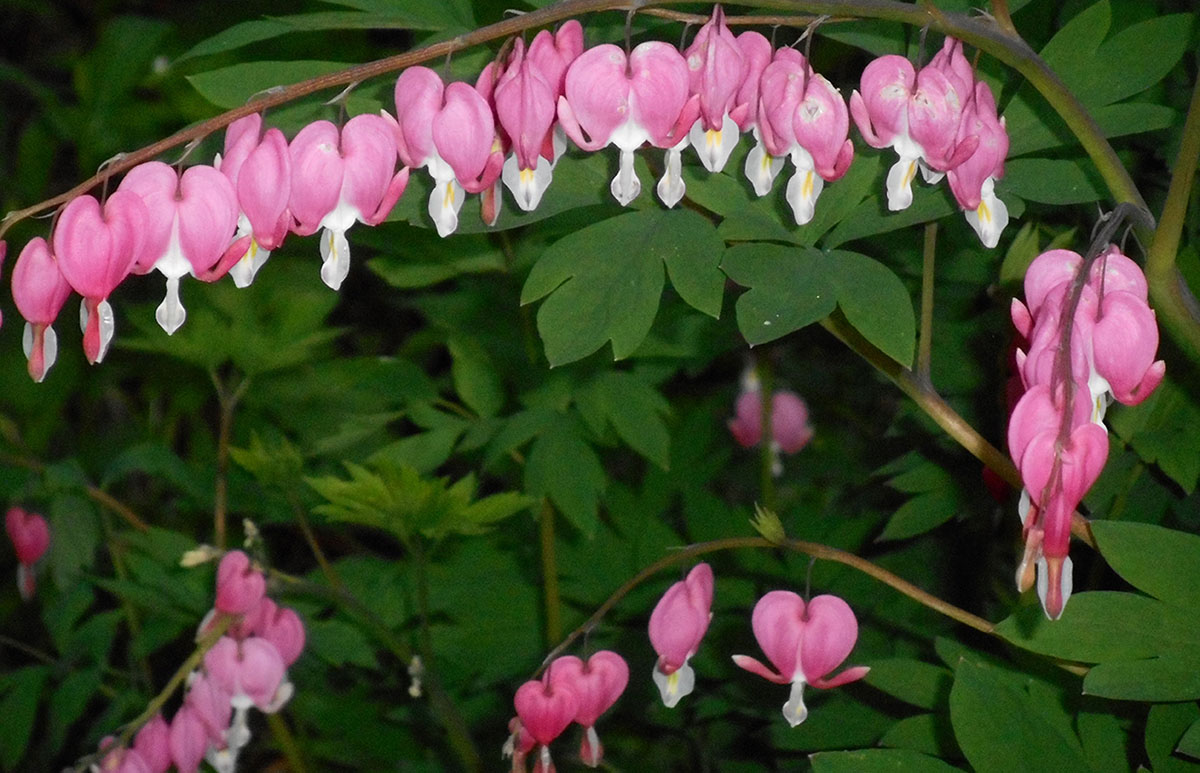By Deborah J. Benoit, Extension Master Gardener, University of Vermont
Have you ever heard of the lady in the bath flower? That’s just one of the common names for bleeding hearts (Lamprocapnos spectabilis, formerly Dicentra spectabilis). If you’re wondering where that name comes from, look at the flower upside down, and you’ll see her.
Other common names include heart flower, lyre flower, or Asian bleeding heart.
There is a bleeding heart (Dicentra eximia) native to the eastern United States that’s commonly referred to as the fringed bleeding heart. It has grayish-green colored foliage and pink to purple-red flowers and, at about 18 inches in height, is somewhat smaller than Lamprocapnos spectabilis.
Interestingly, while Dicentra spectabilis appears related to our native bleeding heart, genetic testing revealed it is not. This led to it being reclassified as Lamprocapnos spectabilis, many cultivars of which are available to home gardeners.
Bleeding hearts are one of the fleeting pleasures of spring in the garden. Each year, this perennial emerges from the ground, its stems reaching upward and outward. Heart-shaped flowers in combinations of red, white, or pink dangle beneath the arching stems.
Native to Asia, Lamprocapnos spectabilis was introduced to European gardens in the mid-1800s and has been a shade garden favorite since that time.
Bleeding hearts are a charming, old-fashioned flower equally at home in a cottage garden with dappled sunlight or in a woodland shade garden. They are hardy in United States Department of Agriculture Plant Hardiness Zones 3 to 9.
They grow 2 to 3 feet tall and wide and bloom for 4 to 6 weeks each spring. The flowers attract bees, butterflies, and hummingbirds and offer a mild, sweet fragrance.
If you enjoy sharing plants or want more of a good thing for your garden, mature plants can be dug up when dormant, and the root clumps divided using a clean shovel or blade.
Plant in early spring as soon as you can work in the soil. You can also plant during the fall when temperatures are mild to give the roots a chance to establish before the ground freezes. Either way, you may want to mark the planting location to avoid accidentally digging up the roots during its dormant period.
For best results, plant in partial shade or filtered sunlight in rich soil that drains well. Amend soil with compost if needed. Heavy soil that retains water may cause root rot.
Add a layer of mulch to help keep moisture levels consistent. Mulch will also help keep the soil cooler during the heat of summer and protect the roots from freezing and thawing in winter.
Feed, if needed, in early spring—according to package directions—to encourage flower and root development.
After it’s finished flowering, the foliage will yellow and die back. The plant will go dormant until the following spring.
Bleeding hearts spread by underground stems called rhizomes or through self-seeding. They’re not considered aggressive in the garden.
They are a low-maintenance plant, but root rot may occur due to standing water or excessive moisture in heavy soil. They’re also a good option if deer or rabbits tend to browse in your garden, as both tend to avoid nibbling on them.
A word of caution: Although bleeding hearts appear delicate and harmless, all parts of the plant are toxic to pets and humans if eaten. Touching them may cause skin irritation, so wear gloves as a precaution.
If you have questions regarding bleeding hearts or other home-gardening questions, please contact the University of Vermont Extension Master Gardener Helpline at go.uvm.edu/gardenquestion.




